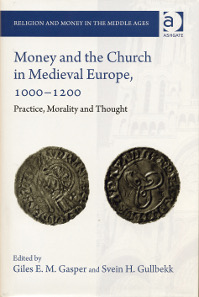by Ursula Kampmann
translated by Annika Backe
June 25, 2015 – In Christian iconography there is a recurring motif: the usurer carrying a heavy money bag around his neck, being pulled by the devil into the abyss of hell. When looking at this church portal with its depiction of the poor sinner one wonders if the Christian Church of Medieval Times really wanted to be involved with money at all. Anyhow, the truth is much more complex that we are inclined to believe.
Svein Gullbekk and Giles Gasper made it their business to explore that truth. Thus, they initiated a joint project in 2013 that provides a platform for all scholars who intend to trace the relationship between the alleged antipodes. Not just numismatists are invited to contribute, but archaeologists, historians, theologians, anthropologists and folklorists as well. The project was preceded by a congress that illustrated how many new discoveries can be made in this particular area. The proceedings of the conference were published in a compilation of papers that is now obtainable.
Giles E. M. Jasper, Svein H. Gullbekk (ed.), Money and the Church in Medieval Europe, 1000-1200. Practice, Morality and Thought. Ashgate Publishing, Farnham, 2015. 304 pages with 21 plates, in color and black and white. 16.3 x 24.1 cm. Hardcover. ISBN: 978-1-4724-5681-6. GBP 70.
Giles E. M. Gasper opens his introduction to the subject-matter with an incredible coin. It is a penny of English King Cnut the Great (1018-1035), which shows, on both sides, the first lines of the Gospel of St. John: “In the beginning was the word, and the word was with God.” The coin symbolically illustrates the conflicting priorities a scholar faces when searching for connections between money and the church.
While the church portals condemn usurers as sinners, bishops, abbots and secular priests were not averse to taking and spending money in order to do business. Many sources testify to this, such as theologian texts on chronicles and records, books of account, acts of the saints, churchly buildings and, last but not least, coins, their iconographic repertoire and their deposition, sometimes probably in a church-related context.
The papers that follow the introduction are divided into three large parts. In the first part four researchers study the attitudes to money within the church. Turpe lucrum – filthy lucre? Rory Naismith critically assesses the assumption that these two words capture the universal attitude of the church towards money, which increasingly gained currency in the High Middle Ages. Giles Gasper examines the monastic sources and what they have to say on that matter. The perception of counterfeit money is tracked by Greti Dinkova-Bruun while the work of Alan of Lille on the economic virtue is the topic addressed by Odd Langholm.
That the church, despite its skepticism towards the new means of payment, made good use of it in every-day life is illustrated by the papers of the next part titled “Buying, Selling and Building: The Use of Money by the Church”. Wim Vroom, author of a monograph on financing cathedral building in the Middle Ages, summarizes his findings here. James Bolton focuses on 12th-century England and Björn Paulsen on Denmark between 1060 and 1160. S. J. and N. J. Mayhew deal with the close relationship between churches and markets in England of the time of the Domesday Book, as expressed in church names like St. Mary le Port or St. Mary in the Market.
The volume’s third part is devoted to the relationship between money and power. What can we say about the connection between coinage, Christian ritual and salvation? The first author, Sebastian Steinbach, deals with one of his favorite subjects: monastic coinage under the Ottonians and Salians. Jens Christian Moesgaard focuses on coinage in Normandy while Lucia Travaini, who has already published an instructive book on the function of coinage in Medieval Italy, researches offerings, alms and tokens of memory. Host Svein Gullbekk concludes the comprehensive conference volume with a look at the situation in Norway.
This book is an eye-opener. Not always that easy to read, its highly fascinating subject-matter takes us back into an era when money was not yet taken for granted. How the moral authority dealt with this new medium, alternating between skepticism and acceptance is examined from many different angles in an exemplary way. This book, too, proves that ‘the church’ was not a single entity but consisted of many different representatives that had to find their own attitude towards money. Naturally, trends emerge, as do deviations from the norm.
The project “Money and the Church in Medieval Europe” will continue until 2016. We are looking forward to all new research results. At any rate, the new series, with this compilation of papers being the first issue, is open to further publications. It is to be hoped that this interdisciplinary approach will inspire many more researchers, shedding light on many more intriguing aspects of this fascinating subject-matter.





